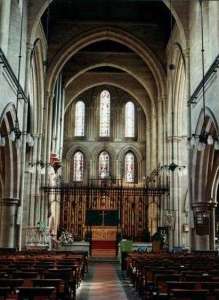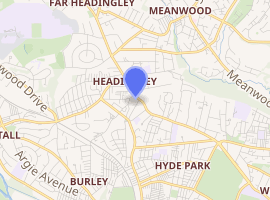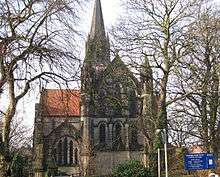St Michael and All Angels Church, Headingley
Headingley Parish Church or the Parish Church of St Michael and All Angels in Headingley, a suburban area of Leeds, West Yorkshire, England is a large Victorian Church of England parish church in the centre of the parish on Otley Road.
| Headingley Parish Church | |
|---|---|
 Parish Church of St Michael and All Angels | |

| |
| 53.8191°N 1.5760°W | |
| Location | Headingley, Leeds, West Yorkshire |
| Country | United Kingdom |
| Denomination | Church of England |
| Churchmanship | Liberal |
| Website | www.st-michaels-headingley.org.uk |
| History | |
| Dedication | St Michael and All Angels |
| Architecture | |
| Architect(s) | J L Pearson |
| Administration | |
| Parish | St. Michael Headingley |
| Deanery | Headingley |
| Archdeaconry | Leeds |
| Episcopal area | Leeds |
| Diocese | Leeds |
| Province | York |
| Clergy | |
| Rector | Tony Whatmough |
| Curate(s) | Kevin Ward Assistant Curate Clive Barrett Associate Minister |
| Laity | |
| Organist/Director of music | Jason Hawkins |
| Churchwarden(s) | Rebecca Crowson Ann Dudzinski |
History
The parish of Headingley was carved out of the once very large parish of Leeds, which at the time also included the districts of Armley, Beeston, Bramley and Hunslet. The first church on the site was built on land given in about 1620 by John Savile. This church remained in place for 210 years and could hold 200 congregants.
The Industrial Revolution brought population booms to northern England and the population of Headingley increased to 2,000 warranting the creation of a vicarcy in 1849 and the building of a larger, 600-seater, church in 1838 (architect (R D Chantrell).
However, this church was not to last. Further increases in population meant that a new church was needed. Today's church is the third on the site and was consecrated in 1886.
With the growth in the local population a new parish of Far Headingley was created, and St Chad's Church, Far Headingley was built in 1868. The two churches work together, for example by holding early Sunday morning communion services alternately, and both participate in Churches Together in Headingley.
Building and associated buildings


The church was designed by J L Pearson, architect of Truro Cathedral. It was built from 1884 to 1886, and the north porch was added and the spire completed in 1890.[1] It is built of gritstone with a tiled roof, and is Grade II* listed. The church wall and gate piers are Grade II listed.
The Parish Hall was built in 1834[1] or 1844[2] as the Headingley National School, and is Grade II listed, as is the former Parochial Institute in Bennett Road, built in 1877 by George Corson and now used as offices.
Services
Worship at the Church is in the liberal catholic tradition of the Church of England, with two of the four Sunday services being sung by the church's choir.
Sunday
- 08.00 am Holy Communion
- 10.00 am Parish Eucharist
- 12.30 pm Holy Communion
- 06.30 pm Evensong
Monday
- 09.15 am Morning Prayer
Wednesday
- 10.00 am Morning Prayer
- 10.30 am Holy Communion
Thursday
- 08.00 am Holy Communion
Friday
- 09.15 am Morning Prayer
Incumbents of Headingley
| Period | Vicar of Headingley |
|---|---|
| In 1632 | Robert Dobson |
| In 1641 & 1642 | John Greenwood |
| In 1650 | ? Barratt |
| In 1657 | ? Bates (? Alexander Bate) |
| 1662–[1671] | William Robinson |
| [1671]–1675 | Richard Crashaw |
| 1675–1676 | John Briggs |
| 1676–1711 | Joseph Eammonson |
| 1711–1713 | John Benson |
| 1713–1730 | John Claphamson |
| 1730–1732 | John Murgatroyd |
| 1732–1746 | Samuel Dodgson |
| 1746–1764 | John Moore |
| 1764–1769 | Samuel Disney |
| 1769–1782 | William Lupton |
| 1782 | Jonathan Colton |
| 1782–1836 | John Smithson |
| 1836–1863 | William Williamson |
| 1863–1865 | William Fox Whitbread Torre |
| 1865–1881 | Henry Tuckwell |
| 1881–1913 | Frederick John Wood |
| 1913–1918 | George Arthur Hollis |
| 1918–1933 | Richard Henry Malden |
| 1933–1956 | Rowland John Wood |
| 1956–[1966] | Ralph Emmerson |
| [1967]–1981 | Christopher Luxmore |
| 1981–1991 | Owen Arnott Conway |
| 1991–[2001] | Michael Cross |
| Period | Priest in Charge |
| [2001]–2011 | David William Peat |
| 2012–2014 | Michael Anthony Whatmough |
| Period | Team Rector |
| 2014 – | Michael Anthony Whatmough |
References
- Wrathmell, Susan; Minnis, John (2005). Leeds. Pevsner architectural guides. Yale U.P. pp. 246–248. ISBN 0-300-10736-6.
- Historic England. "Headingley Parish Hall, St Michael's Road (1256120)". National Heritage List for England. Retrieved 18 January 2008.
External links
| Wikimedia Commons has media related to St Michael and All Angels' Church, Headingley. |
- Church website
- St Michael & All Angels, Headingley at achurchnearyou.com
- Historic England. "Church, Grade II* (1255967)". National Heritage List for England.
- Historic England. "Wall and gate piers, Grade II (1255935)". National Heritage List for England.
- Historic England. "Parish Hall, Grade II (1256120)". National Heritage List for England.
- Historic England. "Former Parochial Institute, Grade II (1255909)". National Heritage List for England.